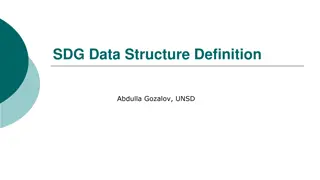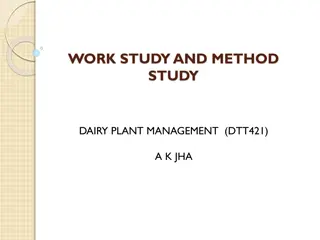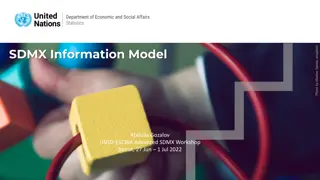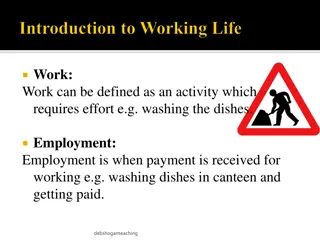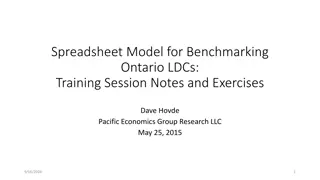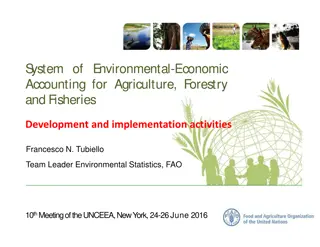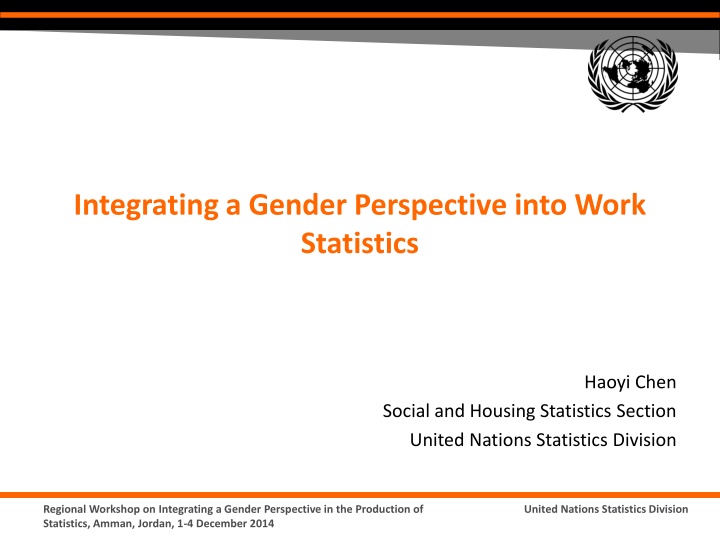
Integrating a Gender Perspective into Work Statistics: Enhancing Gender Relevance in Data Production
Learn how to make work statistics more gender relevant by ensuring comprehensive coverage of gender issues, improving data quality from a gender perspective, and identifying key gender-related factors in labor market statistics. Explore the importance of understanding gender differences and addressing data gaps for a more inclusive approach to statistical reporting.
Download Presentation

Please find below an Image/Link to download the presentation.
The content on the website is provided AS IS for your information and personal use only. It may not be sold, licensed, or shared on other websites without obtaining consent from the author. If you encounter any issues during the download, it is possible that the publisher has removed the file from their server.
You are allowed to download the files provided on this website for personal or commercial use, subject to the condition that they are used lawfully. All files are the property of their respective owners.
The content on the website is provided AS IS for your information and personal use only. It may not be sold, licensed, or shared on other websites without obtaining consent from the author.
E N D
Presentation Transcript
Integrating a Gender Perspective into Work Statistics Haoyi Chen Social and Housing Statistics Section United Nations Statistics Division Regional Workshop on Integrating a Gender Perspective in the Production of Statistics, Amman, Jordan, 1-4 December 2014 United Nations Statistics Division
How to make work statistics more gender relevant? A. Ensure comprehensive coverage of gender issues Producing data disaggregated by sex is not enough! Identify gender issues in the world of work Identify available data sources & gaps B. Improve quality of work statistics from a gender perspective Frameworks, concepts, definitions that recognize differences Methods that reduce underreporting & misclassification C. Facilitate understanding of gender differences Highlight gender issues in presentation of data Often requires detailed disaggregation to identify differences Regional Workshop on Integrating a Gender Perspective in the Production of Statistics, Amman, Jordan, 1-4 December 2014 United Nations Statistics Division
A. Ensure comprehensive coverage Scope & objectives of work statistics Identify gender issues Identify data needs to address gender issues Assess existing sources of data Regional Workshop on Integrating a Gender Perspective in the Production of Statistics, Amman, Jordan, 1-4 December 2014 United Nations Statistics Division
Work & Labour market statistics: Scope and objectives (19th ICLS, 2013) Describe and monitor labour markets Participation in employment, characteristics, working conditions Extent of underutilization, labour market access and integration Measure & participation in all forms of work (paid & unpaid) Contribution to economy (national accounts / satellite accounts) Contribution to household livelihoods and wellbeing Assess differences in participation Urban / rural , women / men, children / youth / adults, etc. Regional Workshop on Integrating a Gender Perspective in the Production of Statistics, Amman, Jordan, 1-4 December 2014 United Nations Statistics Division
Identify gender issues Data needs Forms of work performed (paid & unpaid) Labour force status Barriers to labour force entry Occupation, industry, employment status Union membership Occupational injuries Earnings, working time, benefits, social security Gender differences -Levels & patterns of work and labour market participation -Characteristics of the work -Working conditions -Contributions & returns from work Personal & context variables Education Family constraints Intra-household & gender roles Community expectations Access to physical & financial assets Discrimination on the job market -Age, sex, education, marital status -Family constraints (presence of children by age groups, other dependent members, child care ) -Area context (urban /rural, regions) -Personal ownership of assets (land, livestock) -Employment experience, seniority Regional Workshop on Integrating a Gender Perspective in the Production of Statistics, Amman, Jordan, 1-4 December 2014 And in the workplace United Nations Statistics Division
Identify gender issues: 4 dimensions 1. Forms of work (paid & unpaid) carried out 2. Labour market access / exit 3. Characteristics and conditions of work 4. Contributions and returns for their work Regional Workshop on Integrating a Gender Perspective in the Production of Statistics, Amman, Jordan, 1-4 December 2014 United Nations Statistics Division
1. Forms of work (paid & unpaid) Do they engage in work for pay or profit? Employment Do they provide unpaid household services? Own-use providers of services Do they engage in subsistence agriculture, fishing? Own-use producers of goods, subsistence foodstuff producers Do they participate in unpaid community / village work? Volunteer work Regional Workshop on Integrating a Gender Perspective in the Production of Statistics, Amman, Jordan, 1-4 December 2014 United Nations Statistics Division
Illustration: Forms of work ILO Department of Statistics Regional Workshop on Integrating a Gender Perspective in the Production of Statistics, Amman, Jordan, 1-4 December 2014 United Nations Statistics Division 8
2. Labour market access Do they have work for pay / profit ? Employment Do they look / are available for work for pay / profit? Unemployment Do they work for pay /profit or look for work? Labour force Do they enter and exit the labour market? Labour turnover, life cycle patterns Regional Workshop on Integrating a Gender Perspective in the Production of Statistics, Amman, Jordan, 1-4 December 2014 United Nations Statistics Division
Labour force participation rate, by sex Source: United Nations, 2010 Regional Workshop on Integrating a Gender Perspective in the Production of Statistics, Amman, Jordan, 1-4 December 2014 United Nations Statistics Division
3. Characteristics & conditions of their work Tasks & duties in their job - occupations Kind of goods / services produced - industries Employment relationship - status in employment Security and stability contract type, duration Type of employer - institutional sector Type of establishment formal, informal, household Type of place where they work - place of work Hazardousness of their work occupational injuries, illnesses Voice and representation union density, collective agreements Benefits provided -social security coverage, maternity leave Regional Workshop on Integrating a Gender Perspective in the Production of Statistics, Amman, Jordan, 1-4 December 2014 United Nations Statistics Division
Illustration: Occupations with highest concentration of women / men Source: ILO Department of statistics Regional Workshop on Integrating a Gender Perspective in the Production of Statistics, Amman, Jordan, 1-4 December 2014 United Nations Statistics Division
4. Contributions & returns for their work Working time Hours worked, working time arrangements Income from employment Wages, salaries, commissions, tips Profits / losses Overtime payments, other regular & irregular payments Social security benefits Contribution to households, community & economy Value of production for own-final use Value of paid and unpaid work to national production & satellite accounts United Nations Statistics Division 13 Regional Workshop on Integrating a Gender Perspective in the Production of Statistics, Amman, Jordan, 1-4 December 2014
Illustration: time spent on paid and unpaid work Source: World s Women 2010 Regional Workshop on Integrating a Gender Perspective in the Production of Statistics, Amman, Jordan, 1-4 December 2014 United Nations Statistics Division
Unpaid work in GDP Regional Workshop on Integrating a Gender Perspective in the Production of Statistics, Amman, Jordan, 1-4 December 2014 United Nations Statistics Division
Official sources of work statistics Different sources exist, with different purposes Population and housing census Household surveys Labour force surveys (LFS) Household income & expenditure surveys (HIES) Time-use surveys (TUS) Establishment-based censuses & surveys Administrative records Regional Workshop on Integrating a Gender Perspective in the Production of Statistics, Amman, Jordan, 1-4 December 2014 United Nations Statistics Division 16 ILO Department of Statistics
Improve quality of work statistics - Frameworks, concepts, definitions that recognize gender differences - Methods that reduce underreporting & misclassification Regional Workshop on Integrating a Gender Perspective in the Production of Statistics, Amman, Jordan, 1-4 December 2014 United Nations Statistics Division
New work statistics framework (Resolution I, 19th ICLS, 2013) Address gender bias in recognition of ALL work (paid and unpaid) Make visible participation patterns & quantify contributions Inform policies targeting different forms of work, paid & unpaid Working conditions, remuneration, social protection, work life balance, social inclusion & cohesion Regional Workshop on Integrating a Gender Perspective in the Production of Statistics, Amman, Jordan, 1-4 December 2014 United Nations Statistics Division
Forms of Work (III): 5 distinguished By main intended destination & transaction type Work Source: ILO (i.e. ALL activities to produce goods and services) For own final use (by households) For use by others (i.e. other units) For remuneration (i.e. for pay or profit) Without remuneration Other work activities (e.g. unpaid compulsory work) S Own-use production work Unpaid trainee work Employment (work for pay or profit) Volunteer work Goods Services S G G G Goods S Services United Nations Statistics Division SNA labour input Regional Workshop on Integrating a Gender Perspective in the Production of Statistics, Amman, Jordan, 1-4 December 2014
Illustration: Participation of WAP in different forms of work (%) Source: ILO Regional Workshop on Integrating a Gender Perspective in the Production of Statistics, Amman, Jordan, 1-4 December 2014 United Nations Statistics Division
Illustration: Own use providers of services by sex and activity cluster (%WAP) Most unpaid household services predominantly performed by women, except for household repairs Source: ILO calculations based on national data (LFS-CWIQ, 2010) Regional Workshop on Integrating a Gender Perspective in the Production of Statistics, Amman, Jordan, 1-4 December 2014 United Nations Statistics Division
Classification by: Main reason for not being in labour market Personal reasons Own illness, disability Studies, training Family related reasons Pregnancy, family or household responsibilities Refusal by family Labour market reasons Past failure in finding a job, gave up looking for jobs Lack of experience, qualifications or jobs matching skills Lack of jobs in the area Considered too young or too old by prospective employers Lack of infrastructure No roads, transport, employment services in the area Other sources of income Pensions, rents Social barriers Discouragement Regional Workshop on Integrating a Gender Perspective in the Production of Statistics, Amman, Jordan, 1-4 December 2014 United Nations Statistics Division
To reduce underreporting & misclassification Issues in measurement Regional Workshop on Integrating a Gender Perspective in the Production of Statistics, Amman, Jordan, 1-4 December 2014 United Nations Statistics Division 23
Reduce gender biases in data collection Instrument design Add probes (questions) and examples to better capture activities likely to be underreported (secondary, casual, part/-time self-employment jobs) Use reference periods that take account of different gender roles Field operations Interviewer training (raise awareness of concepts, activities likely to go unreported, social expectations & roles, multiple activities of women) Mixed teams of interviewers (men / women) Avoid proxy responses, reduce interviewer interpretation by providing full questions to be read verbatim Data processing, coding Collect detailed information for industry and occupation Reduce coding based on assumptions of typical gendered occupations Regional Workshop on Integrating a Gender Perspective in the Production of Statistics, Amman, Jordan, 1-4 December 2014 United Nations Statistics Division
Suggested activities for gender units and gender focal points Review questionnaires, manuals & training for surveys and censuses: Work topics covered (main topics + causal factors) Use of additional questions on WHY not working, not seeking work etc.) Use of probing questions, activity lists / sketches Examples given in the manuals (should be free of gender bias) Degree of details used in classifications Coverage of gender aspects in the training Discuss data quality with survey/census team Get involved in data quality assessments at the end of data collection Careful assessment of data for adequate interpretation Regional Workshop on Integrating a Gender Perspective in the Production of Statistics, Amman, Jordan, 1-4 December 2014 United Nations Statistics Division
Facilitate understanding of gender differences Highlight gender issues in presentation of data Detailed disaggregation to identify differences Regional Workshop on Integrating a Gender Perspective in the Production of Statistics, Amman, Jordan, 1-4 December 2014 United Nations Statistics Division
Basic table for gender analysis Title Women Men Sex distribution N % N % %W %M A B C Total Source 100 100 Regional Workshop on Integrating a Gender Perspective in the Production of Statistics, Amman, Jordan, 1-4 December 2014 United Nations Statistics Division
Group exercise Using the handout provided, do the following: 1. Identify key gender issue(s) 2. Determine key message(s) to be highlighted 3. Propose a title / heading that highlights the gender issue shown 4. Draft a short paragraph explaining key message(s) 5. Discuss its relevance for labour market and social policies 6. Was the information provided sufficient? -If no, which additional information is needed? Regional Workshop on Integrating a Gender Perspective in the Production of Statistics, Amman, Jordan, 1-4 December 2014 United Nations Statistics Division
37% Regional Workshop on Integrating a Gender Perspective in the Production of Statistics, Amman, Jordan, 1-4 December 2014 United Nations Statistics Division
Visit us at: http://unstats.un.org/unsd/gender/default.html Regional Workshop on Integrating a Gender Perspective in the Production of Statistics, Amman, Jordan, 1-4 December 2014 United Nations Statistics Division



